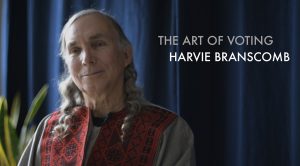The Art of Voting
11 videos, each ca 5 min
These short videos are excerpted from a long interview conducted in March 2019 with Harvie Branscomb, founder of the monitoring site ElectionQuality.com. Harvie is a long-time campaigner for oversight and reform of electoral technology and practice in his home state of Colorado, and across the US. The videos collate 1-2 minute discussions of topics arising from the introduction of electronic voting systems, including ‘Efficiency vs. Transparency’, ‘Verifying Voter Intent’, ’Software Independence’, ‘Biometric Risk’, and ‘Vendor Technology and Federal Standards’. Particularly instructive are Harvie’s elucidation of the demands of verifiability – a verification system must be independent of the system that register votes, down to the lowest level of software and hardware –and the distinction that he draws between the theoretical verifiability of a voting mechanism and practices of verification.
Vimeo [01] [02] [03] [04] [05] [06] [07] [08] [09] [10] [11] Archive.org entire quicktime for download [01-11]

The electoral process has many points of vulnerability. What risks are inherent in specific voting methods? And how did foreign interference impact on the 2016 election?
What has driven the introduction of mechanical and electronic voting methods? What were the consequences of the ‘hanging chads’ in the 2000 election? What specific risks accompany DRE (Direct Record Electronic) voting?
PART 3: VERIFYING VOTER INTENT
How voter intent may be incorrectly captured in the ballot. Balancing voter accessibility, ballot legibility, and verifiability in machine voting. Obstacles to challenging the machine record. What motivates the return to paper ballots? Designing audits to mitigate election risk.
The impact of mechanisation on voter identification. How well do photographic and biometric ID methods work, remotely and in-person? How can voter privacy be balanced with prevention of identity fraud?
Deanonymisation techniques can undermine the secrecy of the ballot. How can voter confidentiality be balanced with the transparency required during audit?
How federal law lags, and state law accommodates, vendor innovation. Who owns elections? What conflicts of interests arise between voting machine vendors, election officials, and citizens.
PART 7: STATE, DISTRICT, PRECINCT
Localism in US democracy leads to specificity and complexity of ballot questions. How do districts on the ballot and precinct reporting impinge on verifiability and voter anonymity?
The state as innovator in voting methods. What are the benefits and drawbacks of universal mail-in ballots and centralised vote counts?
Targeted electioneering, truth in politics, and freedom of speech. Obstacles to candidacy and the advantages of incumbency. How might an alternative voting system address the perceived lack of choice among candidates?
PART 10: MAIL & INTERNET VOTING
Mail-in ballots in the western states of the US. How does Internet/online voting trade the risk of fraud and coercion for convenience? How does it compare with hand-marked paper ballots in terms of security and transparency? Could blockchain provide a solution?
PART 11: SEEKING ELECTION QUALITY
What motivates Harvie Branscomb’s concern with election quality? What critical properties must an ideal voting method have? Should voting be mandatory?
